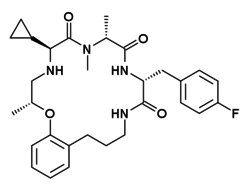Ulimorelin
 | |
| Dữ liệu lâm sàng | |
|---|---|
| Mã ATC |
|
| Các định danh | |
Tên IUPAC
| |
| Số đăng ký CAS | |
| PubChem CID | |
| ChemSpider | |
| KEGG | |
| Dữ liệu hóa lý | |
| Công thức hóa học | C30H39FN4O4 |
| Khối lượng phân tử | 538.653 g/mol |
| Mẫu 3D (Jmol) | |
SMILES
| |
Định danh hóa học quốc tế
| |
Ulimorelin (INN, USAN) (tên mã phát triển TZP-101) là một loại thuốc có cấu trúc peptide tuần hoàn đã được sửa đổi, hoạt động như một chất chủ vận chọn lọc của thụ thể tiết ra hormone tăng trưởng ghrelin (GHSR-1a).[1] Không giống như nhiều loại thuốc có liên quan, ulimorelin có ít hoặc không ảnh hưởng đến hormone tăng trưởng (GH) giải phóng ở chuột.[2] Tuy nhiên, giống như ghrelin và các chất chủ vận ghrelin khác, ulimorelin không kích thích giải phóng GH khi tăng đồng thời yếu tố tăng trưởng giống như insulin 1 (IGF-1) ở người.[3] Nó đã được nghiên cứu để tăng cường nhu động đường tiêu hóa, đặc biệt là trong dạ dày [4] và hỗ trợ phục hồi chức năng ruột sau phẫu thuật đường tiêu hóa, trong đó thuốc giảm đau opioid được sử dụng để giảm đau sau phẫu thuật có thể làm nặng thêm tình trạng táo bón hiện có.[5][6][7][8] Trong khi ulimorelin đã được chứng minh là tăng cả nhu động ruột trên và dưới ở chuột,[9] và cho thấy kết quả khả quan ban đầu ở người,[10][11] nó thất bại trong thử nghiệm lâm sàng quan trọng trong hậu phẫu ruột.[12]
Một tác dụng phụ phổ biến của ghrelin là giảm huyết áp. Ulimorelin đã được chứng minh để ức chế sự co mạch của động mạch chuột in vitro gợi ra bởi các chất chủ vận α1 -adrenoceptors phenylephrine và methoxamine, và tăng sức căng động mạch ở nồng độ cao.[13] Tuy nhiên, ảnh hưởng đến huyết áp không được quan sát thấy trong các thử nghiệm lâm sàng ở người.[4][7]
Tham khảo[sửa | sửa mã nguồn]
- ^ Hoveyda, H.R.; Marsault, E.; Gagnon, R.; Mathieu, A.P.; Vézina, M.; Landry, A.; Wang, Z.; Benakli, K.; Beaubien, S. (ngày 22 tháng 12 năm 2011). “Optimization of the potency and pharmacokinetic properties of a macrocyclic ghrelin receptor agonist (Part I): Development of ulimorelin (TZP-101) from hit to clinic”. J Med Chem. 54: 8305–20. PMID 22106937.
- ^ Fraser GL, Hoveyda HR, Tannenbaum GS. Pharmacological demarcation of the growth hormone, gut motility and feeding effects of ghrelin using a novel ghrelin receptor agonist. Endocrinology. 2008 Dec;149(12):6280-8. doi: 10.1210/en.2008-0804 PMID 18719021
- ^ Gutierrez, M.; Shaughnessy, L.; Cummings, D.R.; Pezzullo, J.; Reeve, R.; Reilly, R.; Kosutic, G (2007). “Ghrelin Agonist (TZP-101): Safety, Pharmacokinetics and Pharmacodynamics: A Multi-dose Evaluation in Healthy Volunteers”. AMS. 24.
- ^ a b Wargin W, Thomas H, Clohs L, St-Louis C, Ejskjaer N, Gutierrez M, Shaughnessy L, Kosutic G. Contribution of protein binding to the pharmacokinetics of the ghrelin receptor agonist TZP-101 in healthy volunteers and adults with symptomatic gastroparesis: two randomized, double-blind studies and a binding profile study. Clin Drug Investig. 2009;29(6):409-18. doi: 10.2165/00044011-200929060-00004 PMID 19432500
- ^ Popescu I, Fleshner PR, Pezzullo JC, Charlton PA, Kosutic G, Senagore AJ. The Ghrelin agonist TZP-101 for management of postoperative ileus after partial colectomy: a randomized, dose-ranging, placebo-controlled clinical trial. Dis Colon Rectum. 2010 Feb;53(2):126-34. doi: 10.1007/DCR.0b013e3181b54166 PMID 20087086
- ^ Greenwood-Van Meerveld B, Kriegsman M, Nelson R. Ghrelin as a target for gastrointestinal motility disorders. Peptides. 2011 Nov;32(11):2352-6. doi: 10.1016/j.peptides.2011.03.014 PMID 21453735
- ^ a b Bochicchio G, Charlton P, Pezzullo JC, Kosutic G, Senagore A. Ghrelin agonist TZP-101/ulimorelin accelerates gastrointestinal recovery independently of opioid use and surgery type: covariate analysis of phase 2 data. World J Surg. 2012 Jan;36(1):39-45. doi: 10.1007/s00268-011-1335-9 PMID 22072430
- ^ Shaw M, Pediconi C, McVey D, Mondou E, Quinn J, Chamblin B, Rousseau F. Safety and efficacy of ulimorelin administered postoperatively to accelerate recovery of gastrointestinal motility following partial bowel resection: results of two randomized, placebo-controlled phase 3 trials. Dis Colon Rectum. 2013 Jul;56(7):888-97. doi: 10.1097/DCR.0b013e31829196d0 PMID 23739196
- ^ Shaw, M.; Pediconi, C.; McVey, D.; Mondou, E.; Quinn, J.; Chamblin, B.; Rousseau, F. (tháng 7 năm 2013). “Safety and efficacy of ulimorelin administered postoperatively to accelerate recovery of gastrointestinal motility following partial bowel resection: results of two randomized, placebo-controlled phase 3 trials”. Dis Colon Rectum. 56 (7): 888–897. doi:10.1097/dcr.0b013e31829196d0. PMID 23739196.
- ^ Wargin, W.; Thomas, H.; Clohs, L.; St-Louis, C; Ejskajaer, N.; Gutierrez, M.; Shaughnessy, L.; Kosutic, G. (2009). “Contribution of protein binding to the pharmacokinetics of the ghrelin receptor agonist TZP-101 in healthy volunteers and adults with symptomatic gastroparesis: two randomized, double-blind studies and a binding profile study”. Clin Drug Investig. 29 (6): 409–18. doi:10.2165/00044011-200929060-00004. PMID 19432500.
- ^ Greenwood-Van Meerveld, B.; Kriegsman, M.; Nelson, R. (tháng 11 năm 2011). “Ghrelin as a target for gastrointestinal motility disorders”. Peptides. 32 (11): 2352–6. doi:10.1016/j.peptides.2011.03.014. PMID 21453735.
- ^ Bochicchio, G.; Charlton, P.; Pezzullo, J.C.; Kosutic, G.; Senagore, A. (tháng 1 năm 2012). “Ghrelin agonist TZP-101/ulimorelin accelerates gastrointestinal recovery independently of opioid use and surgery type: covariate analysis of phase 2 data”. World J Surg. 36 (1): 39–45. doi:10.1007/s00268-011-1335-9. PMC 3243849.
- ^ Fraser, GL; Venkova, K.; Hoveyda, HR; Thomas, H.; Greenwood-Van Meerveld, B. (2009). “Effect of the ghrelin receptor agonist TZP-101 on colonic transit in a rat model of postoperative ileus”. Eur J Pharmacol. 604: 132–137. doi:10.1016/j.ejphar.2008.12.011.
